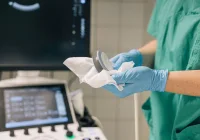Understanding how pregnancy and breastfeeding modify mammographic appearance is essential for accurate imaging interpretation and informed screening decisions in women of reproductive age. A longitudinal analysis of sequential mammograms in a high-risk cohort provides individual-level evidence of substantial, time-linked changes in breast size, fibroglandular composition and imaging parameters across prepregnancy, lactation and postweaning. Automated volumetric measurements captured marked increases in breast volume, fibroglandular tissue and volumetric density during lactation, followed by partial reversal after breastfeeding ceased. Concomitant shifts in compression and dose add practical considerations for image quality and radiation exposure. Together, these data characterise a dynamic trajectory rather than a simple return to baseline, underscoring the importance of physiological context when evaluating mammograms in the peripartum period.
Quantified Tissue Changes Across Timepoints
The cohort included 39 women at elevated risk for breast cancer, with a mean age of 38.7 years at the lactation examination. Three sequential mammograms per participant spanned prepregnancy, lactation and postweaning, enabling within-person comparisons. Imaging was performed predominantly with tomosynthesis, followed by digital mammography and a small number with contrast-enhanced mammography. The mean interval from prepregnancy to lactation mammography was 17.3 months and from lactation to postweaning was 14.4 months. At the time of imaging, breastfeeding duration averaged 3.8 months.
Density classification shifted appreciably during lactation. Most women were categorised as extremely dense at that timepoint, with the remainder classified as heterogeneously dense. Median BI-RADS density increased from prepregnancy to lactation, then decreased after weaning but did not fully regress to the initial value.
Must Read: AI in Diagnostic Mammography Matches Radiologist Accuracy
Automated volumetric assessment captured parallel quantitative changes. From prepregnancy to lactation, breast volume increased by 45.1 percent, fibroglandular tissue volume rose by 138.5 percent, and volumetric breast density increased by 53.2 percent. From lactation to postweaning, these measures declined by 23.3 percent, 52.8 percent and 27.3 percent respectively. Importantly, when comparing prepregnancy with postweaning, breast volume, fibroglandular tissue volume and volumetric density remained higher after breastfeeding had ended. This pattern indicates that while the pronounced lactational rise in size and density recedes, breasts may settle at a new postlactational baseline rather than fully returning to the prepregnancy state.
Illustrative cases reflected these trends. Sequential views demonstrated clear increases in breast volume, fibroglandular content and percentage density between prepregnancy and lactation, followed by reductions after weaning. In one example, disproportionate reduction in overall size relative to fibroglandular tissue yielded an atypical postweaning density increase, highlighting variability in individual trajectories despite consistent overall patterns.
Compression and Dose Considerations During Lactation
Imaging parameters also changed during lactation in ways that are relevant for acquisition and interpretation. Among women imaged with the same modality at all three timepoints, mean breast compression decreased by 22.3 percent during lactation compared with prepregnancy and showed no significant difference between lactation and postweaning. Lower compression during lactation likely reflects increased size, elasticity and tenderness, factors that may influence image quality and lesion conspicuity.
Radiation dose differed across timepoints as well. The average dose during lactation was 3.1 mGy, representing a 20 percent increase compared with both prepregnancy and postweaning. This rise occurred despite standardised views and reflects the combined effects of tissue composition and acquisition conditions in the lactating breast. Together with reduced compression, these changes present practical trade-offs for technologists and radiologists working to maintain diagnostic performance while accommodating physiological alterations associated with breastfeeding.
The temporal spacing of examinations supports interpretation of these imaging shifts. Lactation mammograms occurred a few months into breastfeeding, and postweaning examinations were performed more than a year later, allowing time for involutional changes to stabilise. Although technique varied across the cohort, a defined subset underwent identical modality across all three timepoints to reduce measurement variability for compression and dose comparisons.
Clinical Context, Imaging Pathways and Constraints
These findings sit within a wider clinical context in which density, tissue composition and vascular changes can complicate detection and characterisation of malignancy around pregnancy and lactation. Increased mammographic density is recognised for masking potential lesions and for its association with elevated risk, while longitudinal density behaviour can further inform risk trajectories. In high-risk women who commence annual screening at a younger age, lactation-related increases in density and adjustments in compression may constrain the performance of mammography, particularly when pregnancy-associated breast cancer is a concern.
Diagnostic pathways in this population incorporate modality selection tailored to physiological state. Ultrasonography, with its non-ionising nature and utility for palpable concerns, is a primary tool for evaluating breastfeeding women. Contrast-enhanced MRI is contraindicated during pregnancy because of concerns regarding gadolinium exposure, whereas breast MRI during lactation is considered feasible but may be affected by marked background parenchymal enhancement, which can reduce lesion conspicuity and specificity. Diffusion-based MRI techniques are under investigation for characterising lactational microstructure and may mitigate some of the limitations imposed by enhancement, though these approaches are not yet widely adopted in clinical practice.
Several constraints temper generalisation. The retrospective design limits control over confounders such as weight change or concurrent therapies that can influence density independently of gestational processes. Timing relative to pregnancy and breastfeeding varied across individuals, and imaging modality was not uniform at every timepoint for all participants, introducing potential technical variability. The sample size was modest, and mammographic properties may differ across racial and ethnic groups, which can affect external validity. Automated volumetric tools, while objective and reproducible, may be sensitive to positioning and breast shape, factors not specifically controlled here. These considerations emphasise the need for prospective work with standardised protocols, broader representation and careful control of potential confounders.
Pregnancy and lactation produce pronounced, measurable shifts in mammographic appearance, with substantial rises in breast volume, fibroglandular tissue and volumetric density during breastfeeding, coupled with reduced compression and higher dose at acquisition. After weaning, values decline but often remain above prepregnancy levels, suggesting a new baseline rather than full reversion. For clinicians and imaging teams caring for high-risk women in the peripartum period, recognising these temporal patterns can aid modality selection, optimise technique and support nuanced interpretation aligned with physiological state, while ongoing research refines best practice across pregnancy, lactation and the transition to postweaning.
Source: Journal of Breast Imaging
Image Credit: iStock










